Lest We Forget: In Memory of Maidenhead and Maidenhead Norfolkians Players Who Lost Their Lives in The Two World Wars Part Six: Second World War
05/12/2022 - 10.32
Mark Smith and Matthew Shaw
This is the sixth in a series of articles that commemorates the lives of Maidenhead and Maidenhead Norfolkians players who made the ultimate sacrifice in World War One and World War Two, based on the Maidenhead United FC match day programme series entitled Lest We Forget.
Lawrence Edward Crawshaw
S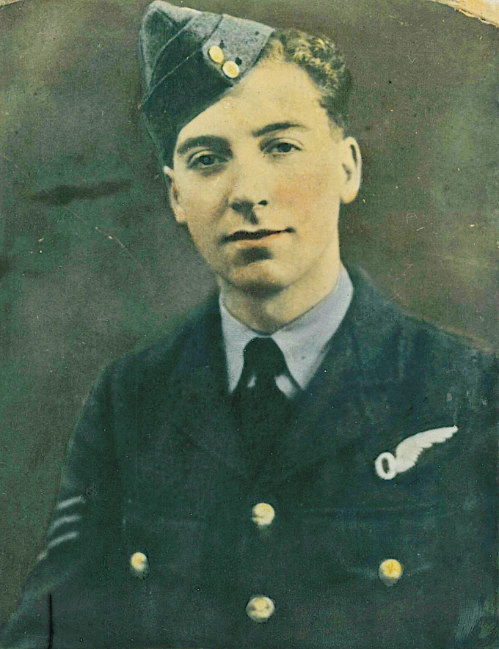
Source: Erica Tyler-Mollen (Family)
Lawrence Edward Crawshaw was born on the 5th October 1919, in Reading and was the son of Joseph Edward Crawshaw from Rawmarsh, Yorkshire and Kathleen Audrey Elizabeth Crawshaw (née Keate) of Reading and they were married in the Berkshire town on the 10th May 1919. Joseph, in addition to his day job, played football for various teams. Lawrence had three siblings, Audrey, Betty and Alan. Audrey was born on the 20th January 1922 and she married a Canadian, Floyd Omer Tyler, who was overseas fighting with the RCAF, on the 13th December 1941, and moved to Canada once the war was over. They had five children Josephine, Kathleen, Christine, Patricia and their youngest, a son, named Lawrence William Tyler. Audrey lives today in Port Alberni, British Columbia, Canada. Betty Constance was born on the 17th October 1924 in Reading and married Erik Rob on the 12th January 1945. They had two children Elizabeth and Allison. Betty lives today in Edinburgh. Alan Crawshaw was born on the 31st March 1939 in Reading and married Janet. They had two children Mark and Gary. Gary played football for a number of teams including Wycombe Wanderers and Luton Town.
Lawrence made his debut for Maidenhead United in August 1937 and played predominantly for the Reserve team although he assisted the first team when required. His final game was in March 1940, against Wycombe Wanderers in the Great Western Combination.
Lawrence went to Wilson Central School and was a part of the Flying Club and subsequently trained to become a pilot. He worked at Petty and Son Printers, and everyone who knew him called him Laurie. When he signed up to join the RAF they needed navigators and so that is what he trained to do. (Laurie is pictured above, wearing his uniform which featured a single-winged aircrew brevet with a wreath containing the letter "O" above his left breast pocket denoting his specialisation).
He was engaged to be married in April 1941, to Joan Leicesten and was supposed to be home during Christmas 1940, but Laurie switched with someone else to remain on service longer to ensure he could be home in April for the wedding.
Laurie was based at Oban in Scotland. On the 23rd December 1940, a merchant ship, the SS Breda, which was part of an assembling convoy mustered off the island of Lismore was attacked by two HE111 Luftwaffe aircraft. The SS Breda sustained flooding damage and had to be beached in Ardnamucknish Bay. The Breda subsequently slid off the underwater shelf on which it had been perched and sank. Its cargo included race horses, a pack of hounds, a monkey, thirty Tiger Moth aircraft, three Hawker Hind biplanes, assorted vehicles and footwear. A lot of the debris from SS Breda was carried on the tide to just outside Oban Bay where it was to cause a further disaster on the evening of the 27th December.
A Sunderland Flying Boat (Type 1 of 210 Squadron) was being flown by a young Australian pilot, Ivor Meggitt, and was attempting a routine night landing off Maiden Island, north of Oban Bay, when returning from a routine patrol. The aircraft landed successfully but immediately struck an object in the freezing water which ripped open the aircraft's hull and flipped it over on its back. Flight Lieutenant Meggitt and nine of the remaining ten aboard, including Sergeant Lawrence Crawshaw, drowned when the Sunderland sunk. The object struck in the dark at 9.17pm that evening was probably one of the several horse boxes from the SS Breda which, with dead animals inside acting as buoyancy aids, kept the boxes near the surface thus becoming lethal objects to hit in a thin-hulled Sunderland landing at speed.
Laurie is listed on the Runnymede Memorial (photo below).
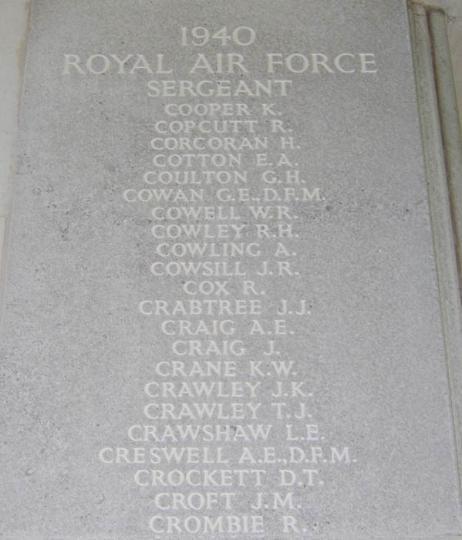
Source: Erica Tyler-Mollen (Family)
1st team appearances = 4, 1 goal
Debut - 25th December 1937 at Windsor and Eton (Spartan League)
Final appearance - 25th March 1940 at Wycombe Wanderers (Great Western Combination)
Known Reserve team appearances = 36, 1 goal (would probably have been more but our records are incomplete)
Debut - 28th August 1937 at Bushey United (Spartan League Division 2 Western section)
Final appearance - 6th May 1939 v Polytechnic Reserves (Spartan League Division 2 Western section)
George James Hearman
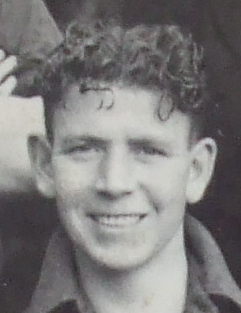
George Hearman pictured in a team photograph of North Town FC. Source: Beryl Hearman (Family)
George James Hearman was born in 1916, the son of Frederick George Hearman and Mary Louise Hearman of Norfolk Park Cottages, Maidenhead. George had eight siblings, five brothers – Albert, Ted, John, Frederick and Ron and three sisters - Alice, Mary and Edith.
George was educated at the East Street School and was well known about the town where he worked as a milkman. George began his footballing career with North Town and made his debut for Maidenhead United in early 1937, as a Reserve player although by the end of the 1938/39 season, he featured in the first team as centre-half. He was a member of the 1939 Berks and Bucks Cup winning side defeating Windsor and Eton 3-2 in a second replay at Marlow and George was utilised in that game as a midfield player.
George married Irene Alexandra Preston at Maidenhead Registry office in the winter of 1940 and they had two children, Anthony, born on the 29th November 1941 and Nicholas, born on the 2nd January 1945 (and who sadly passed away on 29th December 2014). Anthony, known as Tony, worked as a Quantity Surveyor and married Beryl Emery on the 2nd April 1966. They had two children, Ruth (born 1974) and Michael (born 1977) and subsequently two grandchildren when Ruth had two boys, George and William, after marrying John Etches. Nicholas lived in Maidenhead and was a sheet metal worker and married Brenda Began in September 1965, and had two children Nicola (born 1967) and Glenn (born 1972). Nicola has two children, Joshua and Molly, and Glenn, who lives in Fifield, also has two children, Ben and Sophie. Nicholas and Brenda moved to Filey where they spent a very happy ten years before sadly Nicholas developed Motor Neurone Disease.
George had joined the forces at the outbreak of World War Two and was in the Somerset Light Infantry before being transferred to the 7th Battalion Seaforth Highlanders shortly before he went abroad a fortnight after D-Day in 1944. He was killed on the Western Front on the 4th April 1945, aged 29, in tragic circumstances. As part of a “mopping up expedition”, George was returning from the frontline on a raised wooden pathway alongside a container transporting guns when the pathway collapsed and the container fell onto George trapping him in the mud and ultimately leading to his death. His commanding officer, in a letter to the family, described George as “…popular and unassuming, very conscientious, and one of my best men”.
George was laid to rest in the Reichswald Forest War Cemetery at Kleve near the German/Dutch border. George’s widow, Irene, eventually remarried becoming Irene Walker and passed away on 17th April 1972.
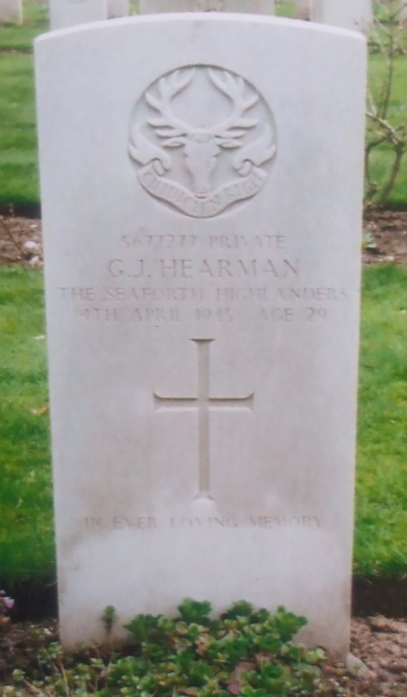
George’s headstone at the Reichswald Forest War Cemetery. Source: Beryl Hearman (Family)
1st team appearances = 32
Presumed Debut - 25th September 1937 at Cambridge Town (Spartan League Premier Division)
Presumed final appearance - 4th March 1944 v RAF High Wycombe (Great Western Combination)
Member of the Maidenhead United team that won the Berks and Bucks Senior Cup in 1939
Known Reserve team appearances = 34 (would have been more but detailed information unavailable)
Presumed Debut – 22nd April 1937 at Aylesbury United Reserves (Spartan League Division 2)
Presumed final appearance - 1st April 1939 v Bushey United (Spartan League Division 2)
Jesse William Robinson

Source: Steve Mundy (Family)
Jesse William Robinson was born on the 8th May 1913 in Maidenhead and was the youngest son of William and Ruth Robinson (nee Howard). William was a groom and coachman and Ruth a coachman’s daughter. The couple were married in 1912.
Jesse grew up in Ray Park Cottages with his parents and elder brother, Tom, before moving to Westborough Road. After leaving school he worked in St Martin’s Jam factory before leaving to work at Jacksons Paper Mill in Bourne End where he was a leading hand on the presse pâté machines used to turn wood pulp into sheets for making the final paper. Jesse met Olivia (Olive) Baston and they were married on Christmas Day 1937. They lived in Princess Street, Maidenhead where they had their only child, Jacqueline Ruth (Jacky), born in January 1939, who still lives in the town.
Jesse had made his debut for the club in the Reserves in October 1936 and played one first team game that season standing in for Bill Bunce. By 1938, he had become the regular first team custodian and although he lost that position to Len Abery in September 1938, Jesse returned to keep goal towards the end of the season and was a member of the 1938/1939 Berks and Bucks Cup winning side defeating Windsor & Eton 3-2 in May 1939, when Abery had a poisoned toe.
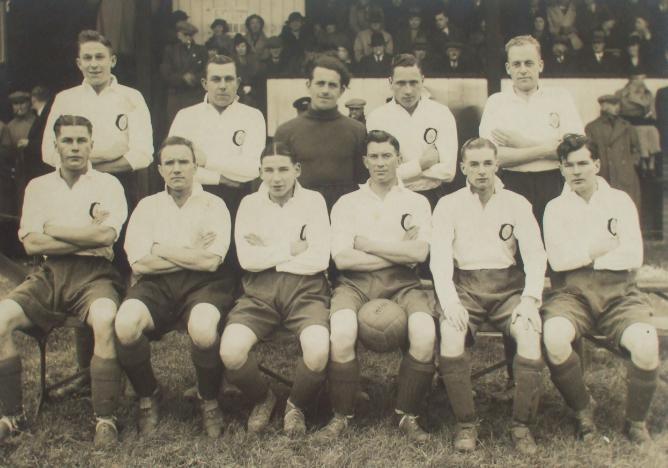
Jesse Robinson, Back Row, Centre. Source: Steve Mundy (Family)
Jesse was conscripted in November 1940 and joined the Oxford and Bucks Light Infantry. He commenced basic training in Oxford and served in the UK until mid-June 1943 when he boarded a ship bound for North Africa. During the voyage he was transferred to the 8th Battalion of the Durham Light Infantry (8th DLI). Their mission was to be the invasion of Sicily which commenced on the10th July 1943.
Jesse was involved in one of the bloodiest battles of the invasion at Primosole Bridge. Following an airborne assault on the night of the13th July, the bridge was captured by the small British force to secure the river crossing to enable access to the Catania plain. It was essential for the infantry troops to reach the bridge by the following evening to support the small airborne force in the face of repeated enemy attacks. Three battalions, including the 8th DLI, set off but by the time the first troops reached the bridge in the late evening of the 14th July the lack of ammunition from the repeated enemy attacks had allowed the enemy to retake control. On the morning of the 16th July, the 8th DLI launched an attack that ultimately proved successful with the support of 6th and 9th DLI with the enemy eventually surrendering the following day. The fighting was generally considered to be the fiercest of the Sicily campaign and between the three Durham Light Infantry Battalions, 500 men were killed, wounded or reported missing.
After the securing of Sicily and Italy by the 8th Army, in October 1943, the DLI embarked on the Dutch freighter Sibajak and sailed in convoy out of Augusta Harbour for Algiers, Gibraltar, and then England. Jesse arrived home in early November 1943. After a brief period of leave, which enabled him to play a couple of games for the club, Jesse was recalled to commence training for D-Day.
On the 4th June 1944, he embarked a ship ready for the invasion on the 6th June 1944. On that morning, the troops of the 151st Infantry Brigade (comprising the 6th, 8th and 9th Battalions DLI) landed at Gold Beach. Thanks to the efforts of the earlier tanks and troops, most of the enemy resistance had been nullified which enabled the 151st to move inland from their position towards Ver-sur-Mer and later Meuvaines, with limited resistance.
The 8th DLI moved off on the 9th June heading in a south-west direction and were engaged in many battles in the Normandy Bocage. The first such battle was for control of St Pierre and after several days of intense fighting the village was secured. After several more days of intense fighting, with only a couple of days of respite, the 13th July was a memorable day for the 8th DLI – the first issue of bread since landing on Normandy as up to this point they had survived on rations and biscuits. After this, the 8th DLI made good progress until they reached the small village of Ourville which was held by the enemy.
During the fighting to take control of Ourville, Jesse was wounded on the 26th July 1944. It is not clear what these wounds were but Jesse remained with the 8th DLI and died several weeks later on the 7th October, in Nijmegen, Holland, aged just 31. He is buried at the Jonkerbos War Cemetery near Nijmegen. Jesse was awarded the 1939-1945 Star, Italy Star, France and Germany Star, Defence Medal and the War Medal 1939-1945.
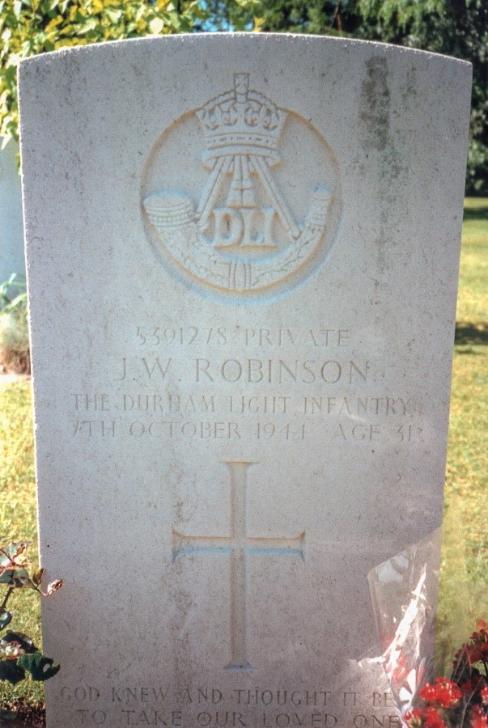
Source: Steve Mundy (Family)
1st team appearances = 38 Debut 5th December 1936 v Windsor and Eton (Berks and Bucks Benevolent Cup)
Final appearance 27th November 1943 v Windsor Works (Great Western Combination)
Member of the Maidenhead United team that won the Berks and Bucks Senior Cup in 1939
Known Reserve team appearances = 29 (would have been more but detailed information unavailable)
Presumed Debut - 31st October 1936 v Wendover (Spartan League Division 2)
Presumed Final appearance - 6th May 1939 v Polytechnic Reserves (Spartan League Division 2)
Additional Information and Sources
Berkshire Yeomanry Museum website
Emma Barnett
Mary Bentley
Dave Cannon
Nicola Carpenter
John Dance
Gillian Healey
Tony and Beryl Herman
Paul Melia
Steve Mundy
Lesley Norris
Carrie Pike
Steve Roberts
Steve Rolls
Malcolm Summers
David Tubby of the Great Yarmouth History and Archaeological Society
Erica Tyler-Mollen
Biographies
Mark Smith attended his first Maidenhead match in March 1976 and continued to watch games fairly regularly for the next forty years. He was responsible for producing the club’s first ever “Handbook” in 1978, and has researched and chronicled the club’s history ever since. He was responsible for organising five exhibitions on the club, two at Maidenhead Library and three at the Maidenhead Heritage Centre (“The Magpies Story”). He has also written four books – Maidenhead FC 1870 – 1914; Maidenhead United 1919 – 1995; Maidenhead United 1995 - 2005, and, to coincide with the club’s 140th anniversary, published a 352-page detailed history entitled “One for Sorrow, Two for Joy” in 2011.
Aside from writing many series for the match programme (such as “Past Maidenhead Greats” and “An A-Z of Maidenhead United”) together with standalone articles, Mark also compiled “One of the Fifteen” on the fifteen players who appeared in the first ever Maidenhead FC match in December 1870, and “Lest We Forget” on those associated with Maidenhead FC and Maidenhead Norfolkians who lost their lives during the two World Wars. He also arranged to have the Maidenhead United Heritage website created - www.mufcheritage.com in 2009.
Matthew Shaw has played for several local football teams and became interested in the history of local football as members of his family have always been involved in football in the Berks and Bucks Counties as far back as the 1870s.
When researching family involvement in clubs in the combined counties, Matthew focused on pre First World War local football and the impact the war had on local teams.
Matthew has researched the Maidenhead Norfolkians FC in depth and helped the Maidenhead United FC Historian Mark Smith on all things Norfolkians. This meant he was also greatly involved in Mark's series "Lest We Forget" that was featured in Maidenhead United home programmes, as Matthew had already researched a large number of the town's footballers from both Senior and Junior clubs who had lost their lives in the Great War.
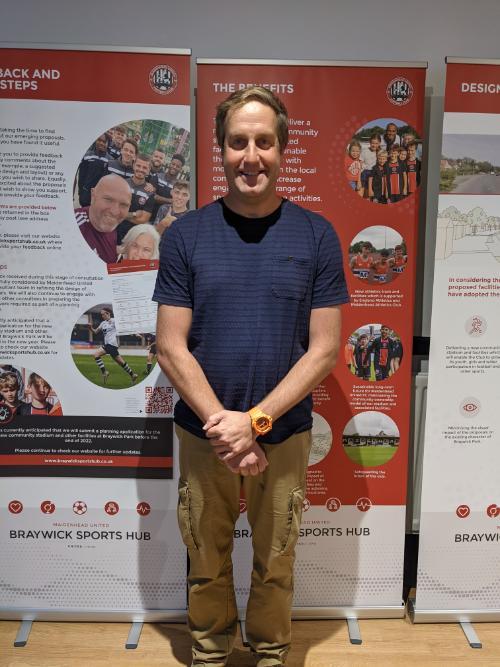


/prod01/wlvacuk/media/departments/digital-content-and-communications/images-2024/Diane-Spencer-(Teaser-image).jpg)
/prod01/wlvacuk/media/departments/digital-content-and-communications/images-18-19/220325-Engineers_teach_thumbail.jpg)
/prod01/wlvacuk/media/departments/digital-content-and-communications/images-2024/240509-Menopause-Research-Resized.jpg)
/prod01/wlvacuk/media/departments/digital-content-and-communications/images/Maria-Serria-(teaser-image).jpg)
/prod01/wlvacuk/media/departments/digital-content-and-communications/images-2024/241014-Cyber4ME-Project-Resized.jpg)
/prod01/wlvacuk/media/departments/digital-content-and-communications/images-2024/240315-Research-Resized.jpg)
/prod01/wlvacuk/media/departments/digital-content-and-communications/images-2024/BDA-group-photo.jpg)
